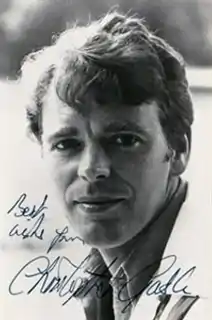Christopher Gable
Christopher Michael Gable, CBE (13 March 1940 – 23 October 1998) was an English ballet dancer, choreographer and actor.
Christopher Gable CBE | |
|---|---|
 | |
| Born | Christopher Michael Gable 13 March 1940 London, UK |
| Died | 23 October 1998 (aged 58) |
| Spouse(s) | Carole Needham |
Born in London, Gable studied at the Royal Ballet School, joining the Sadler's Wells Royal Ballet in 1957. He was promoted to soloist in 1959 and principal in 1961.
Gable's roles included Romeo in the Kenneth MacMillan production of Romeo and Juliet,[1] Mercury in Offenbach's comic operetta Orpheus in the Underworld, a production that was filmed and released on DVD,[1] and Colas in La fille mal gardée.[2] Gable frequently partnered with Lynn Seymour.[3]
Gable suffered from a chronic rheumatoid condition in his feet[4] and left the Royal Ballet in 1967 to pursue a career in acting.[5] He appeared in a number of television and film productions directed by Ken Russell, including the BBC films Song of Summer (1968) and Dance of the Seven Veils (1970), Women in Love (1969), The Music Lovers (1971), an adaptation of The Boy Friend (1971), The Lair of the White Worm (1988), and The Rainbow (1989).[6] Other roles included that of John, valet and friend of Prince Edward, in the Cinderella film musical The Slipper and the Rose (1976), the composer Peter Cornelius in Wagner (1983), Mercury in the 1983 BBC television production of Orpheus in the Underworld,[7] and ambiguous villain Sharaz Jek in the 1984 Doctor Who serial The Caves of Androzani.[8] He also appeared on stage in the 1974 West End musical The Good Companions.[9]
In 1982, Gable founded the Central School of Ballet[6] with Ann Stannard. Five years later he was appointed Artistic Director of Northern Ballet Theatre.[3] He transformed the small regional troupe into a company of national renown by presenting imaginative new works and staging impressive revivals of old classics. Among the productions mounted during his eleven-year regime were Swan Lake, A Christmas Carol, The Brontes, The Amazing Adventure of Don Quixote, Dracula, Giselle, and The Hunchback of Notre Dame.[10] Many of the projects he created later were performed by other dance companies, including the Atlanta Ballet and the Royal New Zealand Ballet. He played Arthur Ainsley in the 1984 TV British miniseries A Woman of Substance.[11]
Gable was married to dancer Carole Needham.[5] He died from cancer near Halifax, Yorkshire, at the age of 58.[12]
Selected theatre performances
- Lysander in Midsummer Night's Dream, Peter Brook's landmark 1970 production for the Royal Shakespeare Company[3]
- Jack Absolute in The Rivals by Sheridan.One of the two opening productions at the Royal Exchange, Manchester, directed by Braham Murray. (1976)
- Count Hohenzollern in The Prince of Homburg by Heinrich von Kleist. The other opening production, directed by Casper Wrede.(1976)
- John Rosmer in Rosmersholm by Henrik Ibsen. Directed by Casper Wrede at the Royal Exchange, Manchester. (1981)
- Philinte in The Misanthrope by Moliere. Directed by Casper Wrede at the Royal Exchange, Manchester. (1981)
Filmography
| Year | Title | Role | Notes |
|---|---|---|---|
| 1969 | Women in Love | Tibby Lupton | |
| 1970 | The Private Life of Sherlock Holmes | Danseur Nobel | Uncredited |
| 1971 | The Music Lovers | Count Anton Chiluvsky | |
| 1971 | The Boy Friend | Tony | |
| 1976 | The Slipper and the Rose | John | |
| 1988 | The Lair of the White Worm | Joe Trent | |
| 1989 | The Rainbow | Will Brangwen | (final film role) |
Honours and Awards
In 1996 Gable was named a Commander of the Order of the British Empire for his services to British dance.[6] The following year he was awarded the honorary degree of Doctor of Letters by the University of Bradford.[1]
References
- "Gable biography at NorthernBalletTheatre.co.uk". Archived from the original on 17 May 2008.
- Gable biography on the DVD of Orpheus in the Underworld
- Meisner, Nadine (26 October 1998). "Obituary: Christopher Gable". The Independent.
- "articlearchives.com". www.afternic.com. Archived from the original on 5 May 2012.
- OLIVER, MYRNA (3 November 1998). "Christopher Gable, 58; International Ballet Star and Film Actor". Los Angeles Times.
- "Christopher Gable".
- "Orpheus in the Underworld", British Film Institute, retrieved 10 April 2013.
- "BBC - Doctor Who Classic Episode Guide - The Caves of Androzani - Details". www.bbc.co.uk.
- "Christopher Gable | Theatricalia". theatricalia.com.
- "Christopher Gable". HeraldScotland.
- "BFI Screenonline: Woman of Substance, A (1984) Credits". www.screenonline.org.uk.
- Dunning, Jennifer (1 November 1998). "Christopher Gable, 58, Dancer Who Made Switch to Acting (Published 1998)". The New York Times.